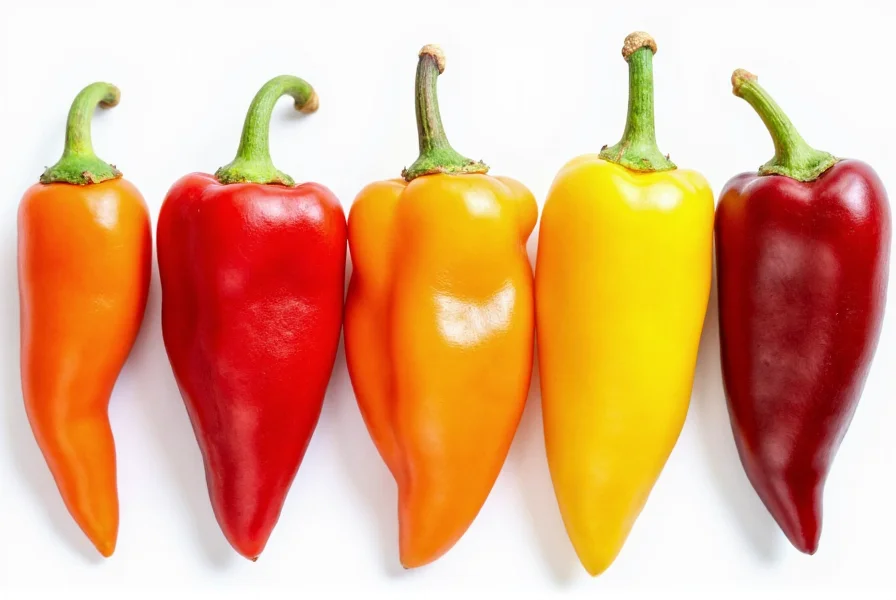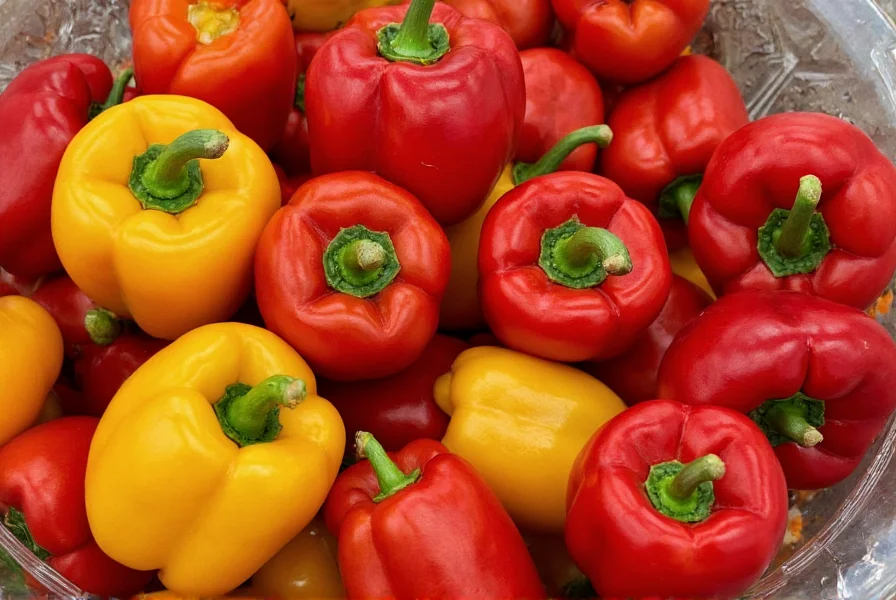Understanding pepper names is essential for gardeners, chefs, and spice enthusiasts who want to navigate the diverse world of Capsicum varieties. The naming complexity arises from regional variations, color stages, and the historical journey of peppers from their South American origins to global cultivation. This comprehensive guide explains the logic behind pepper nomenclature, helping you identify and select the right varieties for your needs.
Scientific Classification of Peppers
Peppers belong to the Capsicum genus within the nightshade family (Solanaceae). Five primary species account for most cultivated peppers:
| Species | Common Examples | Origin | Scoville Range |
|---|---|---|---|
| Capsicum annuum | Bell peppers, jalapeños, serranos | Mexico | 0-50,000 SHU |
| Capsicum frutescens | Tabasco, malagueta | Central America | 30,000-50,000 SHU |
| Capsicum chinense | Habanero, ghost pepper, Scotch bonnet | Amazon Basin | 100,000-2,200,000 SHU |
| Capsicum baccatum | Aji peppers | Andes Mountains | 30,000-50,000 SHU |
| Capsicum pubescens | Rocoto, manzano | Andes Mountains | 30,000-100,000 SHU |
The misnomer "Chinese" in Capsicum chinense resulted from early European explorers mistakenly believing these extremely hot peppers originated in China. In reality, all cultivated pepper species trace back to the Americas, with domestication beginning approximately 6,000 years ago in what is now Mexico and Peru.
Common Pepper Varieties and Their Names
Pepper naming conventions create confusion because the same variety may have multiple names depending on color stage, region, or culinary context. Understanding these patterns helps demystify pepper identification.
Bell Peppers: The Color-Changing Variety
Bell peppers (Capsicum annuum) provide the clearest example of color-based naming. What many don't realize is that red, yellow, and orange bells are simply mature green bells. As they ripen, their chlorophyll breaks down and carotenoids develop, changing both color and flavor profile.

Jalapeño Naming Variations
The jalapeño (Capsicum annuum) demonstrates regional naming differences:
- Chipotle - Smoked, dried jalapeño
- Huachinango - Mexican term for jalapeño
- Cuaresmeño - Larger, smoother-skinned jalapeño variant
- Serrano - Often confused with jalapeños but thinner and typically hotter
Why Peppers Have Multiple Names
Several factors contribute to the complex naming system for peppers:
Regional Terminology Differences
In the United Kingdom, "capsicum" refers to what Americans call bell peppers, while in Australia, "chilli" describes both hot and sweet varieties. The same pepper might be called "aji" in South America, "pimento" in Europe (though this also refers to allspice berries), and "chili" in North America.
Color-Based Naming Conventions
Many peppers receive different names based on their color stage:
- Green bell → Red bell (same plant, different maturity)
- Fresno peppers: Green (milder) vs. Red (hotter)
- Thai chilies: Green (less mature) vs. Red (fully mature)
Heat Level Designations
Some naming conventions directly reference Scoville Heat Units (SHU):
- Pepper X - Claimed to be the world's hottest (3.18 million SHU)
- Carolina Reaper - Former record holder (1.4-2.2 million SHU)
- Habanero - Typically 100,000-350,000 SHU
- Sweet Hungarian - 0-1,000 SHU
Practical Pepper Identification Guide
When identifying peppers, consider these characteristics:
| Characteristic | Identification Clue | Example Peppers |
|---|---|---|
| Shape | Elongated vs. blocky | Serrano (long, slender) vs. Bell (blocky) |
| Surface Texture | Smooth vs. wrinkled | Shishito (smooth) vs. Aleppo (wrinkled) |
| Stem Attachment | Upright vs. pendant | Habanero (upright) vs. Cayenne (pendant) |
| Internal Structure | Number of lobes | Bell peppers (2-4 lobes) |
For example, bell peppers typically have 2-4 lobes at the blossom end. Three-lobed bells tend to be slightly sweeter and contain more seeds than their two-lobed counterparts. This subtle difference matters when selecting peppers for specific culinary applications.

Regional Pepper Naming Guide
Understanding regional terminology prevents confusion when traveling or following international recipes:
North American Terminology
- Chili/chile - Hot peppers (spelling varies regionally)
- Pepper - Can refer to both hot and sweet varieties
- Pimento - Typically refers to the sweet red variety used in olives
European Terminology
- Peperoni - Bell peppers in Italy (not to be confused with American "pepperoni" sausage)
- Pimentón - Spanish smoked paprika
- Paprika - Ground peppers, ranging from sweet to hot
Latin American Terminology
- Aji - General term for peppers in South America
- Chile - Mexican term for peppers
- Uchu - Quechua term used in Andean regions
Common Pepper Misidentifications
Several peppers are frequently confused due to similar appearances:
- Habanero vs. Scotch Bonnet - Habaneros are slightly elongated while Scotch bonnets are more rounded
- Jalapeño vs. Serrano - Serranos are thinner with brighter green color and typically hotter
- Cayenne vs. Thai Bird's Eye - Thai chilies are much smaller but significantly hotter
When in doubt, examine the plant characteristics rather than just the fruit. Different pepper species have distinctive growth habits, leaf shapes, and flower structures that provide more reliable identification than fruit appearance alone.
Practical Applications of Pepper Knowledge
Understanding pepper names isn't just academic—it has real culinary implications:
- Substituting appropriate peppers when recipes call for specific varieties
- Selecting the right pepper for preservation methods (drying, pickling, freezing)
- Matching pepper heat levels to dish requirements
- Choosing varieties for home gardening based on climate and space requirements
For instance, if a recipe calls for "red chilies" without specification, understanding regional context becomes crucial. In Thai cooking, this likely means bird's eye chilies, while in Mexican cuisine it might refer to guajillo or ancho peppers.
Frequently Asked Questions
Why are bell peppers called by different color names?
Bell peppers are named by color because they're the same variety at different ripeness stages. Green bells are immature, while yellow, orange, and red bells are progressively riper. As they mature, their sugar content increases and chlorophyll breaks down, changing both color and flavor profile.
What's the difference between a jalapeño and a serrano pepper?
Jalapeños are larger (2-3 inches), thicker-walled, and typically milder (2,500-8,000 SHU) than serranos, which are smaller (1-2.5 inches), thinner-walled, and hotter (10,000-23,000 SHU). Serranos have a brighter green color and grow in an upright position on the plant, while jalapeños hang downward.
Why is the habanero called 'Chinese' when it's from the Americas?
The species name 'Capsicum chinense' is a historical misnomer. Early European explorers mistakenly believed these extremely hot peppers originated in China rather than the Amazon Basin where they actually evolved. Despite the name, all cultivated pepper species originated in the Americas.
How can I identify pepper varieties when shopping?
Look for shape, color, surface texture, and stem attachment. Bell peppers are blocky with 2-4 lobes; jalapeños are 2-3 inches long with smooth skin; habaneros are lantern-shaped and typically orange. When in doubt, ask about heat level (Scoville units) or intended culinary use, as these provide more reliable identification than names alone.











 浙公网安备
33010002000092号
浙公网安备
33010002000092号 浙B2-20120091-4
浙B2-20120091-4